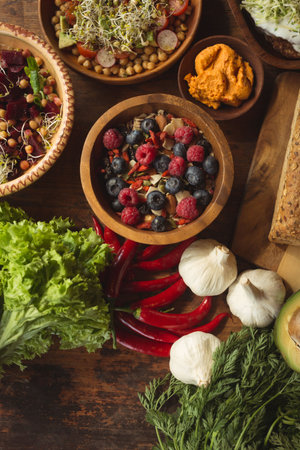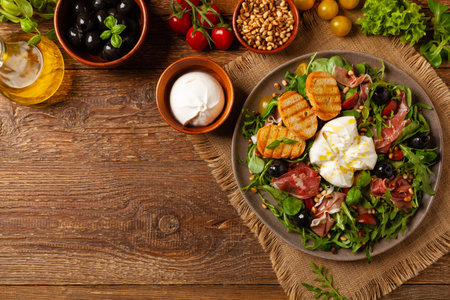1. Introduction to Macro Balancing
Balancing macronutrients, commonly referred to as “macros,” is a fundamental aspect of maintaining good health and supporting an active lifestyle. Macronutrients—carbohydrates, proteins, and fats—are the main sources of energy in our diets, each playing distinct roles in bodily functions. Carbohydrates fuel daily activities and mental alertness, proteins are vital for growth and repair, while fats support hormone production and cell health. For Britons, finding the right balance among these nutrients can be particularly relevant given our diverse food culture and seasonal produce. Understanding how to adjust your intake according to local, seasonal British foods not only supports overall well-being but also allows you to make the most of what’s fresh and readily available throughout the year.
Understanding British Seasonal Produce
Eating seasonally is a cornerstone of a balanced and sustainable diet, especially in the UK where the seasons greatly influence food availability. Choosing British seasonal produce not only supports local farmers and reduces your carbon footprint, but also ensures you are consuming foods at their nutritional peak. Seasonal eating aligns perfectly with macro balancing, as it offers variety and freshness throughout the year.
The Importance of Seasonal Eating
Seasonal foods are often richer in flavour and nutrients compared to imported or out-of-season alternatives. By rotating your macro sources according to what’s fresh, you naturally diversify your intake of vitamins, minerals, and phytonutrients, which supports overall health. Additionally, seasonal eating is cost-effective as produce in season tends to be more affordable due to abundance.
Key British Fruits, Vegetables, Grains, and Proteins by Season
| Season | Fruits | Vegetables | Grains | Proteins |
|---|---|---|---|---|
| Spring | Rhubarb, Strawberries | Asparagus, Spring greens, Radishes | Barley | Lamb, Mackerel |
| Summer | Blackcurrants, Cherries, Gooseberries | Cucumber, Courgette, New potatoes | Oats (for porridge or muesli) | Chicken, Trout |
| Autumn | Apples, Pears, Plums | Pumpkin, Beetroot, Leeks | Wheat (wholegrain bread) | Pheasant, Mussels |
| Winter | Kale (as a green), Stored apples and pears | Cabbage, Parsnip, Swede | Rye (rye bread) | Venison, Herring |
Diversifying Your Macro Sources Year-Round
This seasonal approach helps you balance carbohydrates from grains and root vegetables with proteins from locally sourced meats and fish. At the same time, rotating fruits and veg ensures youre covering your micronutrient bases. By understanding what is available each season in Britain and planning meals accordingly, you can naturally balance your macronutrient intake with minimal effort while enjoying food at its best.

3. Incorporating Seasonal Foods into Your Macros
Adopting a macro-balanced diet doesn’t mean you have to forgo local and seasonal British produce. In fact, integrating these ingredients not only enhances nutritional variety but also supports local agriculture and reduces food miles. Here’s how you can practically include British seasonal foods in your daily macro targets, with sample pairings for each season.
Spring: Fresh Beginnings
Spring brings an abundance of greens like asparagus, watercress, and spinach. For protein, pair grilled British lamb or poached eggs with a salad of steamed asparagus and new potatoes. Add a drizzle of rapeseed oil for healthy fats—this trio ensures a balanced plate rich in protein, complex carbs, and beneficial fats.
Summer: Vibrant Variety
British summer yields berries, peas, broad beans, and tomatoes. Combine roasted chicken breast (protein) with a quinoa salad tossed with cherry tomatoes, peas, and fresh mint (carbs), finished with a sprinkle of seeds or a spoonful of cold-pressed linseed oil (fats). This is ideal for lighter meals that still hit all your macros.
Autumn: Hearty Harvest
Autumn’s root vegetables—such as parsnips, swede, and carrots—are excellent carbohydrate sources. Roast them alongside mackerel fillets (protein and omega-3 fats), or try a venison stew bulked out with mushrooms and pearl barley for sustained energy release and macro balance.
Winter: Comfort Foods Redefined
In winter, look for brassicas like Brussels sprouts and cabbage. Slow-cooked beef or lentil casseroles (protein) can be paired with mashed root veg (carbs) and a knob of butter or splash of extra virgin olive oil (fats). These warming dishes keep you satiated while supporting your nutrition goals.
Key Tips for Macro-Balanced Meal Planning
Plan meals around the core protein source first; then layer in seasonal vegetables for carbohydrates and fibre. Use healthy fats from nuts, seeds, or local oils to round off the dish. By rotating ingredients based on what’s locally available each month, you’ll diversify your nutrient intake whilst maintaining macro alignment throughout the year.
4. Typical UK Meals: Macro Makeover
Traditional British cuisine is deeply comforting but often leans towards starchy carbs and saturated fats, especially during colder months. However, with a thoughtful approach, you can adjust classic UK meals to achieve a more balanced macronutrient profile while celebrating the best of local, seasonal produce.
Macro Tweaks for Classic Dishes
Below are some iconic British meals and suggestions for tweaking them using in-season British ingredients to improve their balance of protein, fats, and carbohydrates.
| Traditional Dish | Typical Macros | Seasonal Swap & Macro Boost |
|---|---|---|
| Sunday Roast (Beef, roast potatoes, veg) | High carb (potatoes), moderate protein (beef), moderate fat | Swap roast potatoes for roasted parsnips or swede in winter; add steamed kale or Brussels sprouts for fibre; opt for leaner cuts of beef or include lentils in gravy for added plant protein |
| Fish & Chips | High carb (chips), high fat (battered fish), low fibre | Bake locally caught white fish; use sweet potato wedges instead of chips in autumn; serve with mushy peas and shredded raw cabbage slaw for extra fibre and micronutrients |
| Shepherd’s Pie | High carb (potato topping), moderate protein (lamb/mince), moderate fat | Mix root vegetables like carrot and turnip into mash topping; use lean mince or substitute half with lentils; bulk out filling with winter greens like Savoy cabbage |
| Porridge | High carb (oats), low protein, low fat | Add stewed local apples or pears in autumn/winter; swirl in Greek yoghurt for protein; sprinkle with pumpkin seeds harvested in late summer/early autumn for healthy fats |
Smart Substitutions for Seasonality & Nutrition
The key to balancing macros with traditional UK dishes lies in swapping refined carbohydrates and processed fats for whole, seasonal foods rich in fibre, vitamins, and healthy fats. For example:
- Replace white bread or flour in recipes with wholegrain or oat-based alternatives.
- Add pulses such as British-grown beans or lentils to casseroles and pies to boost plant-based protein and fibre.
- Use locally sourced rapeseed oil—high in unsaturated fats—instead of butter where suitable.
- Incorporate in-season leafy greens like spring spinach, winter kale, or summer watercress as nutrient-dense sides.
Sustainable Eating & Macro Balance Go Hand-in-Hand
Tweaking your favourite British meals not only brings your plate closer to optimal macro balance but also supports local agriculture and reduces food miles. By prioritising what’s fresh and grown on home soil, you’ll naturally eat a wider variety of nutrients throughout the year while enjoying comforting flavours that resonate with British tradition.
5. Shopping and Cooking Tips for British Households
Balancing macros with British seasonal foods is not only beneficial for your health, but it can also be cost-effective and environmentally responsible. Here’s how you can make the most of local, seasonal ingredients while ensuring your meals are macro-balanced and tailored to UK lifestyles.
Sourcing Seasonal Foods Locally
Start by visiting farmers’ markets, farm shops, or local greengrocers. These venues offer fresh produce that aligns with the current season—think Kentish strawberries in summer or Lincolnshire root vegetables in winter. Seasonal food boxes from British suppliers like Riverford or Abel & Cole are another excellent way to access a rotating selection of fruits, veg, and even locally sourced proteins. By purchasing whats in season, you’re likely to get better flavour and nutrition at a lower price point.
Reading UK Food Labels
When shopping in supermarkets, always check food labels for country of origin and nutrition content. Look for the Red Tractor logo, which ensures high standards of farming and food safety within the UK. For macro tracking, pay attention to the “per 100g” values for protein, carbohydrates, and fat—these figures are consistent across UK packaging and make portion planning simpler. Also note any “traffic light” labelling on the front of packs; aim for more greens and ambers for balanced meals.
Budget-Friendly Meal Prep
Macro-friendly eating doesn’t have to break the bank. Use pulses like British-grown lentils and beans as affordable protein sources when meat or fish is pricier out of season. Bulk cook stews or casseroles using seasonal veg such as swede, carrots, and leeks—these keep well in the fridge or freezer and can be portioned out for easy macro tracking during busy weeks. Plan meals around supermarket offers on locally produced items, especially towards closing time when reductions are common.
Practical Cooking Tips
Batch-cooking is key: roast trays of mixed seasonal vegetables to pair with grains or lean meats throughout the week. Use a kitchen scale for precise macro measurements—this is standard practice among fitness enthusiasts in the UK. Try classic British recipes with a modern twist by substituting refined carbs with wholegrains (like swapping white rice for pearl barley) to boost fibre content without compromising tradition.
Summary
By sourcing locally, reading labels carefully, and adopting practical meal prep strategies suited to British households, you can enjoy nutritious, macro-balanced meals year-round—supporting both your wellbeing and UK producers.
6. Sustaining a Macro-Balanced Diet Year-Round
Adopting a macro-balanced diet with British seasonal foods can be both enjoyable and sustainable, but it requires ongoing attention to variety and nutritional adequacy. Here are some strategies tailored for the UK context:
Plan Ahead with the Seasons
One of the most effective ways to maintain variety is to plan meals around what’s in season. The UK’s climate offers a wide range of produce throughout the year—think asparagus in spring, berries in summer, root vegetables in autumn, and brassicas in winter. Use resources like local farmers’ markets or online seasonal food calendars to guide your shopping list.
Batch Cooking and Freezing
Busy lifestyles and unpredictable weather can make it challenging to eat fresh and balanced meals daily. Batch cooking using seasonal produce and freezing portions ensures you always have macro-balanced options on hand. For example, prepare hearty soups in winter or fruit compotes in summer, storing them for future convenience.
Rotate Protein Sources
Diversifying protein helps prevent dietary monotony and supports nutritional adequacy. Alternate between British beef, lamb, oily fish (like mackerel or salmon), eggs, pulses, and plant-based proteins such as lentils or chickpeas. This also addresses environmental concerns by reducing over-reliance on any single source.
Addressing Common Barriers
Cost and accessibility can be barriers to eating well year-round in the UK. To manage costs, buy in bulk when possible, focus on frozen or tinned British produce during off-seasons (which often retains nutritional value), and take advantage of supermarket loyalty schemes. For those with limited kitchen space or time, consider simple recipes requiring minimal equipment—one-pot stews or tray bakes featuring seasonal veg are ideal.
Embrace Flexibility and Mindful Substitutions
No need to follow rigid meal plans; instead, swap ingredients based on availability and preference. If British strawberries are out of season, switch to apples or pears for fruit intake. Likewise, substitute grains like barley or oats for imported rice or quinoa when appropriate—these British staples support both macro balance and sustainability.
By staying attuned to local seasons, preparing ahead, rotating food groups, and remaining flexible with choices, you can effectively sustain a macro-balanced diet all year round while embracing the best that British agriculture has to offer.

